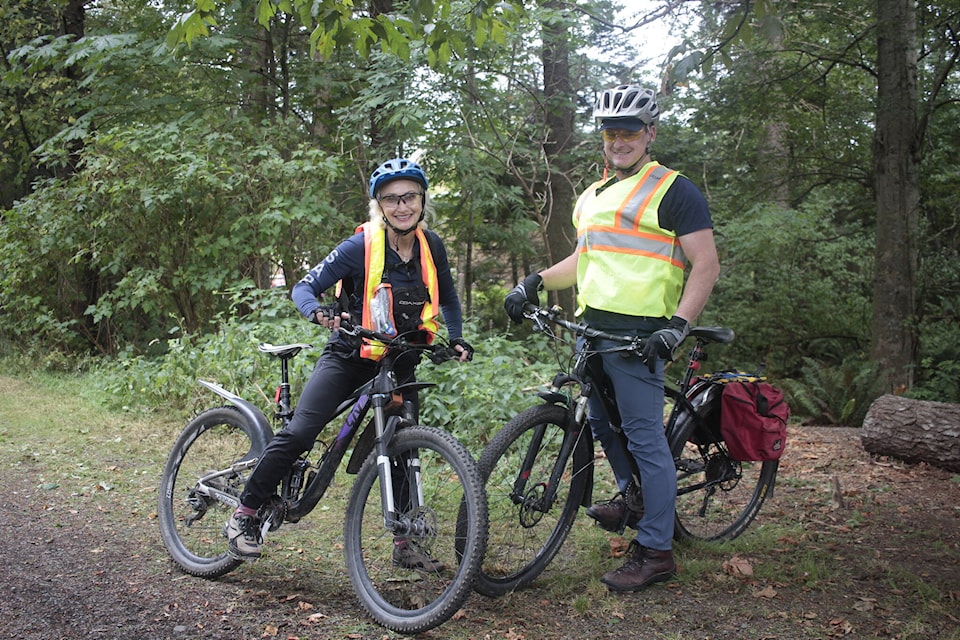David Klein’s bike was a bit scuffed up, but more in a functional-work-truck kind of way than a broken-down-beater kind of way.
It was a 2014 or so Specialized hardtail mountain bike with fast-rolling, 29-inch wheels, full-wrap fenders and red panniers on a back rack that held a small amount of first aid and survival gear. While it had a few chips in the paint, it looked reliable, comfortable and fast, which meant it was perfect for search and rescue.
Klein is one of the members of the Campbell River Search and Rescue (CRSAR) Bike Team, which gets deployed on everything from search and rescue operations within the Snowden Demonstration Forest to urban operations distributing evacuation and other emergency response notifications.
While Klein said that it was more of a utilitarian bike than a fun bike, you could tell he had a fondness for it. It was almost perfect for the job. The only improvement, he said, would be to make it electric.
“If we had an e-bike, a lot of this gear issue would go away because we’d be pedalling, but assisted. When we’re going up into Snowden, you know where they are and you kinda want to get there. You’re panting by the time you’re there,” he said. “With an e-bike, its easier. You wouldn’t have to worry about getting hot and taking off your jacket. It’d be more or less just sitting there pedalling.”
Klein was the first member at the hall, but was quickly joined by Nancy Dwyer, who drove up in a truck with a camper mounted on the back with an equally-loved dual suspension mountain bike attached to a front rack. The pair are part of an 8-10 member squad of rescuers who get deployed around Campbell River on their bikes.
“We get deployed for three different uses, one is for if there’s a flood or a warning that needs to be issued in the community through emergency services, then we can be deployed to hand out notices like evacuation notices or missing person notices if we’re doing an urban search,” Dwyer said. “We’ve had quite a few unhoused people or other people who have gone missing, people with dementia are also very common. We’ve been deployed into the Beaverlodge Lands looking for older people.
“Then there are the bike routes in Beaverlodge and Snowden areas,” she said. “If people go missing out there or they’re lost or they do some sort of beacon, then we’re faster than people on foot to go into those areas where our ATVs are unable to go.”
Search and rescue by bike is not a new thing in B.C. The Campbell River crew has been operational for a few years now, and actually put together the manual that has been adapted by other bike crews across the province. What’s new is the increased amount of people needing their help. With e-bikes and the COVID bike boom, more people are getting out on their bikes, Dwyer said. The thing is, sometimes those people get in over their head and need a bit of help.
“With the advent of electric bikes, that’s increasing the need for us,” she said. “So many people with them are able to go on long rides, but most of them are not really cycling. They get out there, their bikes are heavier, they fall over, their battery runs out or who knows what, then they’re in the middle of nowhere.”
Typically, when the bike crew goes out on a search call, they have three riders on a trail. The first is in front, looking out for hazards like fallen trees, potholes or big rocks. Then two riders are behind scanning either the left or right side of the trail. While they can move quickly, in this situation they pedal at a steady enough rate that they can speak to one another without having to shout, which also means they’re slow enough not to miss anything.
In a rescue situation, speed and efficiency are often the most important thing. That’s where the bike crew shines. They are able to go more places than ATVs and UTVs (Utility Terrain Vehicles or side-by-sides), and are quicker than walking.
“The main advantage of us is on trails,” Dwyer said. “It’s really just us getting there first and assessing the situation. You’re getting out there and being the first person on scene, then you make the assessment.”
“You get a call, and it says one thing. Then it often turns out to be something different,” Klein said. “It’s nice to have someone on our team out on the ground to really tell us what we need.”
One of the team’s hopes is to get equipment upgrades and make the jump to electric pedal assist bikes. However, that’ll come when they feel they really need it. The CRSAR team as a whole decides where money is most needed and their grants and fundraising dollars get allocated that way.
For now, it’s just volunteers, their own bikes and a willingness to get out there and help in any way they can.
RELATED: Courtenay friends head to Arctic Circle on motorcycles to fulfill 30-year dream
